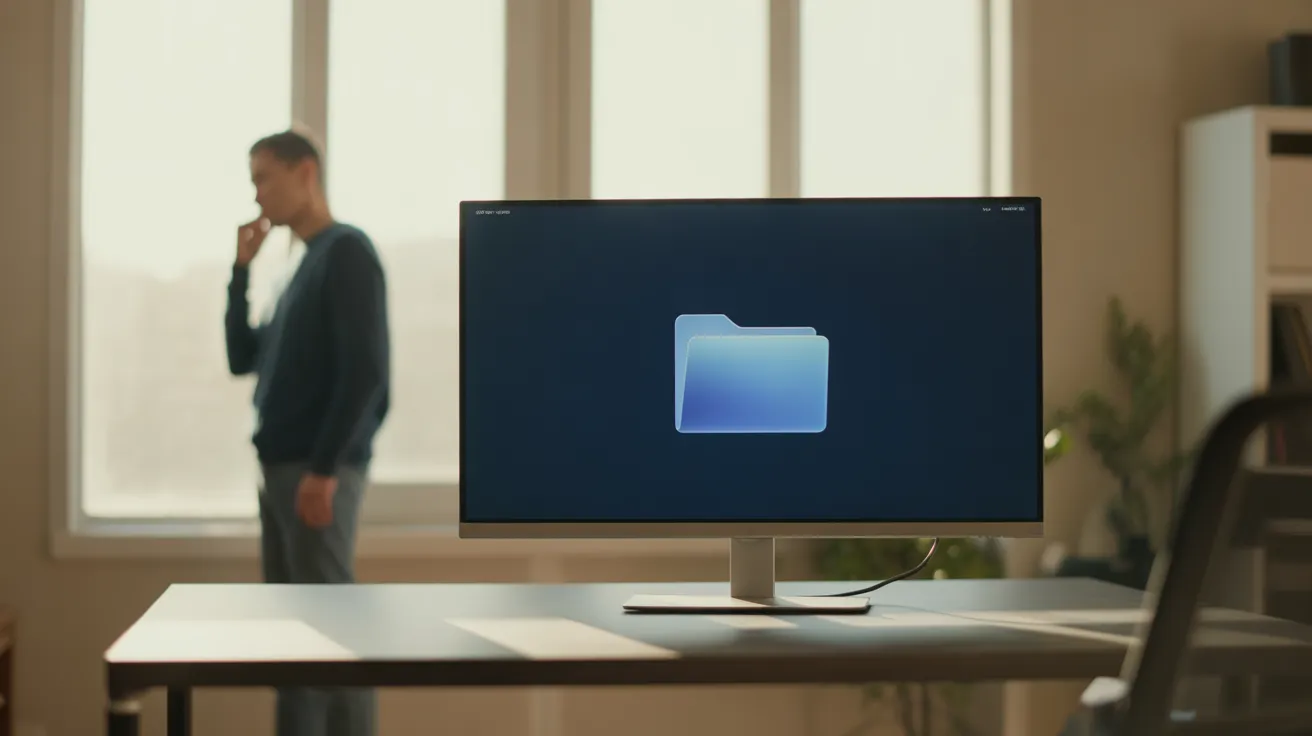
In our physical world, we notice the clutter. The stack of mail on the counter, the pile of books by the bed, the overflowing laundry basket. Each object is a small, silent demand on our attention. We understand that this physical friction creates a low hum of stress in our lives. Yet, we often ignore its digital equivalent: the chaotic desktop, the downloads folder filled with cryptically named files, the inbox with thousands of unread messages. This digital clutter creates the same friction, quietly draining our focus and making every task feel a little harder than it should be.
The common response is to promise ourselves we’ll “get organized” through sheer force of will. We spend a weekend creating a labyrinth of folders and sub-folders, only to abandon the system within a week because it’s too complicated to maintain. The problem isn’t a lack of willpower; it’s a lack of a sustainable system. A truly organized digital life isn’t about perfect, complex hierarchies. It’s about creating an environment where the easiest path is the organized one. It’s about building simple, low-maintenance habits that prevent clutter from accumulating in the first place.
At The Focused Method, we believe in designing systems that work with human nature, not against it. This guide won’t ask you to become a master archivist overnight. Instead, it will show you how to set up simple digital zones, establish effortless workflows, and use tiny, consistent resets to maintain a calm, productive digital space. We will help you build a system for organizing digital files that gives you more time, energy, and mental clarity, transforming your computer from a source of stress into a tool for focused work and peaceful living. Forget the marathon cleaning session; it’s time to learn the simple habits that keep your digital home tidy for good.
📚 Table of Contents
- Create Your Digital Working Zones
- The 10-Minute Digital Reset
- Thriving in Your Digital Square Footage
- From Chaos to Calm: Real-World Examples
- Your Digital Organizing Questions, Answered
- I have years of unsorted digital files and a backlog of paper to scan. Where do I even start?
- How can I get my family or team to follow the new system?
- What’s the best way to organize sentimental digital files like photos and old videos?
- My cloud storage is almost full. How can I manage my digital files without paying for more space?
- Your First Steps to a Stress-Free Digital Workflow
Create Your Digital Working Zones
The first step in any effective organization system is assigning a home for everything. In the digital world, this means creating clear, distinct “working zones.” A working zone is a designated location for a specific type of file or a specific stage of your workflow. When you establish these zones, you drastically reduce the number of decisions you have to make throughout the day. You no longer have to ask, “Where should this go?” The answer is already built into your environment.
Think of your computer’s Desktop. For many, it’s a chaotic dumping ground for screenshots, downloads, and miscellaneous documents. This creates immense visual friction, a term we use to describe the subtle mental fatigue caused by a cluttered environment. Every time you look at your messy desktop, your brain has to process the chaos before it can get to the task at hand. Instead, your Desktop should be treated as prime real estate: a temporary workspace for only the files related to the one or two projects you are actively working on today. Nothing else lives here. At the end of the day, this space is cleared, just like a chef wipes down their station after service.
So where does everything else go? You need two other primary zones. First, create a single folder on your desktop or in your primary documents folder named “01_Process” or “Inbox.” This is the designated landing zone for all new, incoming files—every download, every scanned document, every new file you create that doesn’t have an immediate home. This simple act prevents clutter from spreading across your system. Second, you need your permanent storage, your digital filing cabinet. This will likely be a cloud-based service like Google Drive or Dropbox, or a well-organized folder on your main hard drive.
Within this permanent storage, resist the urge to create a complex, granular folder structure. A label-light approach is far more sustainable. Start with a few broad, high-level categories. For personal use, this might be as simple as `Finances`, `Household`, `Work`, and `Archive`. For a freelancer, it might be `01_Clients`, `02_Admin`, `03_Marketing`, `04_Personal`. Using numbers at the beginning of the folder names keeps them in a logical, consistent order. The goal of this file organization system is to make filing so easy it becomes a reflex. You should be able to drag a file to its home in under three seconds without having to click through five levels of sub-folders.
This zoning system naturally supports the one-touch rule. This principle states that whenever you interact with a new item, you decide its fate immediately. When a new file lands in your “01_Process” folder, you have three choices: act on it (e.g., pay the bill, then file the PDF in `Finances`), file it away for reference, or delete it. The file is “touched” once and sent on its way. This prevents the pile-up that leads to digital chaos and is the cornerstone of a functional workflow for managing your digital life.

The 10-Minute Digital Reset
A brilliant system is useless without a practice to maintain it. The secret to long-term digital organization isn’t a massive, one-time cleanup; it’s a small, consistent act of tidying up. We call this the “digital reset.” A reset point is a pre-scheduled, non-negotiable block of time you use to bring your environment back to its ideal, baseline state. For your digital world, a 10-minute reset at the end of each workday is a transformative habit.
This routine is simple and should become as automatic as shutting down your computer. It consists of three key actions. First, clear your primary working zone: your computer’s Desktop. Take any files you were actively working on and move them to their permanent homes. If you downloaded new files or took screenshots, drag them all into your “01_Process” folder. The goal is to end the day with a completely clear Desktop. This act alone reduces visual friction and allows you to start the next day with a clean slate and a clear mind.
Second, process your “01_Process” folder. This is where you apply the one-touch rule. Open the folder and go through each file one by one. Do not skip any. For each file, make a quick decision. Does this invoice need to be paid? Pay it, and then file the confirmation in your `Finances/Invoices_Paid` folder. Is this a research article for a project? Move it to the appropriate project folder. Is it a duplicate download or an old screenshot you no longer need? Delete it without hesitation. You might not empty the folder completely every single day, but spending just five minutes on this task prevents it from becoming an overwhelming digital junk drawer. This is one of the most crucial digital file management tips for maintaining order.
Third, perform a quick reset of your email inbox. The goal isn’t necessarily “inbox zero” in the strictest sense, but “inbox processed.” Quickly scan for any urgent emails you may have missed. Then, archive any messages that have been dealt with and do not require further action. If an email represents a task, move it to a dedicated “To-Do” folder or use your task management app to log the action item, then archive the email. The objective is to get your inbox down to only items that require a reply or action. This triage prevents your inbox from becoming another source of stress and ensures your communication workflow remains efficient.
Committing to this 10-minute daily ritual is an investment in your future self. It’s a small act of kindness that prevents small messes from snowballing into overwhelming chaos. By creating this reset point, you ensure that your beautifully designed system for organizing digital files continues to serve you, day after day, without requiring a massive burst of willpower or a dreaded weekend cleanup project.

Thriving in Your Digital Square Footage
Just as we have to work within the constraints of a small apartment or a shared office, we also have digital space constraints. Hard drives fill up, and free cloud storage plans hit their limits. Instead of seeing this as a problem, we can use these limitations as a helpful boundary, encouraging us to be more intentional about what we keep. Managing your digital space effectively is a key part of a stress-free file organization strategy.
The most important concept for managing digital space is the distinction between active and archived files. Active files are the documents, projects, and resources you need to access regularly. These should live in your most accessible storage, like a primary cloud folder from a provider such as Evernote or Dropbox, that syncs across all your devices. Archived files, on the other hand, are items you need to keep for legal, financial, or sentimental reasons but don’t need to access frequently. This includes completed client projects from three years ago, old tax documents, or large photo albums. This collection of digital files doesn’t need to take up your prime digital real estate.
Create a dedicated “Archive” zone. This can be a specific folder within your main cloud service, but a more space-efficient strategy is to use a separate, less expensive storage solution. This could be an external hard drive that you connect once a month for backups, or a cheaper, long-term cloud storage service designed for archiving rather than daily access. Once a project is complete or a year’s worth of financial documents are finalized, move the entire folder from your active system into the archive. This single action can free up significant space and reduce the clutter in your day-to-day working environment.
Another simple technique is file compression. For large project folders containing dozens or hundreds of files, you can compress them into a single .zip file before moving them to your archive. This can dramatically reduce the amount of storage space they occupy. It also packages the entire project neatly, preventing stray files from getting separated from the main folder.
Finally, schedule a regular purge. Just like cleaning out a closet, your digital archive benefits from an annual review. Set a calendar reminder once a year to spend an hour going through your archive. You will almost certainly find old project files you no longer need, duplicate documents, or outdated information that can be permanently deleted. Our needs and priorities change, and the files we think are essential today may be irrelevant in five years. By being proactive about culling your archive, you can often manage your digital files for years without ever needing to upgrade your storage plan, keeping your system lean, low-cost, and efficient.

From Chaos to Calm: Real-World Examples
Theoretical advice is helpful, but seeing a system in action brings it to life. Let’s explore how these principles for organizing digital files can transform two common chaotic scenarios into models of calm efficiency. These mini-makeovers demonstrate how a systems-focused approach can create a stress-free workflow.
The Freelance Designer’s Home Office
Meet Alex, a talented graphic designer. Alex’s computer desktop was a disaster zone, littered with screenshots, dozens of versions of the same logo file like `logo_final_v2_final.ai`, and folders for clients mixed with personal photos. Every new project request sent a spike of anxiety through Alex, not because of the work itself, but because of the anticipated struggle to find the necessary files and manage the new ones. The visual friction was draining creative energy.
Alex’s reset started with creating foundational working zones. A main folder called “FREELANCE” was created in the cloud. Inside, the structure was simple: `01_Clients`, `02_Admin`, `03_Portfolio`, and `04_Archive`. The desktop was cleared, with every file moved into a temporary “Process_Me” folder. Then, Alex spent an hour applying the one-touch rule, sorting the files. Inside `01_Clients`, a folder was made for each client. Within each client’s folder, the structure was standardized: `Briefs`, `Assets`, `Drafts`, and `Final_Deliverables`. Old, completed projects were zipped and moved to `04_Archive`. The new rule was simple: the computer Desktop was only for the files related to the single project being worked on that day. At 5 PM, as part of a new reset point, those files were moved to their proper home in the client folder, and the Desktop was left empty, ready for a fresh start the next morning.
The Family’s Digital Command Center
Now consider the Chen family. Their important documents were a mix of physical and digital chaos. School permission slips were on the fridge, bills were in a pile on the kitchen counter, and important emails with medical records were lost in a personal inbox. There was no central hub, causing constant stress and last-minute searches for crucial information. They needed a shared system for their household’s digital file management.
Their solution was to create a shared family account with a cloud service. They established a simple, top-level folder structure: `Finance`, `Household`, `Medical`, `School`, and `Memories`. Inside `Finance`, they created folders for `2024_Taxes` and `Bills_Paid`. In `Household`, they stored scans of appliance manuals and home insurance policies. Each child had a folder under `School` for their report cards and important communications. They designated a small basket on the counter as the physical inbox. Every Sunday evening became their family reset point. They would take 15 minutes to open mail, and using a scanner app on their phone, they would immediately scan and upload documents to the correct folder in the shared drive. The physical paper was then shredded or filed in a small, physical archive box. This new workflow eliminated paper clutter and ensured both parents could always find any document they needed in seconds, from any device.

Your Digital Organizing Questions, Answered
Embarking on a new organization system can bring up specific questions and challenges. Here are answers to some of the most common queries we receive about implementing a new method for organizing digital files and improving your workflow.
I have years of unsorted digital files and a backlog of paper to scan. Where do I even start?
The key is to not try to boil the ocean. Do not start by trying to organize the past. Start with today. First, set up your new, simple folder structure (`01_Process`, `Finances`, `Work`, etc.). From this moment forward, every new file that comes in gets handled by the new system using the one-touch rule. This stops the problem from getting worse. Then, dedicate a small, manageable amount of time each week—perhaps 25 minutes every Friday—to tackling the backlog. Create a big folder called “Old_Files_To_Sort” and dump all your old digital chaos into it. During your weekly session, just sort through a small chunk of that folder. For the paper, use a scanner app on your phone and process five documents a day. The slow, steady progress is far more sustainable than a weekend marathon that leads to burnout.
How can I get my family or team to follow the new system?
Buy-in comes from inclusion and ease of use. Instead of imposing a system, design it with them. Ask your family or team what their biggest frustrations are with the current lack of file organization. Frame the new system as a solution to those specific problems. Most importantly, keep it incredibly simple. If filing a document requires navigating through seven sub-folders, no one will use it. Your system should be so intuitive that the path of least resistance is to use it correctly. Lead by example and be consistent. When others see how much easier the system makes your life, they are more likely to adopt it themselves.
What’s the best way to organize sentimental digital files like photos and old videos?
Sentimental files deserve their own special zone, separate from your working files. Create a top-level folder called “Memories” or “Photos.” Within that, the simplest and most future-proof method is to organize by date, not by event. Create folders by year (e.g., `2023`, `2024`), and within those, by month or specific event date (`2023_07_Beach_Vacation`). This chronological approach prevents you from having to remember what you named an event folder years from now. For your absolute favorite photos, create a separate “Favorites” folder with copies of the best-of-the-best from each year. This gives you a curated highlight reel to enjoy without having to sift through thousands of pictures.
My cloud storage is almost full. How can I manage my digital files without paying for more space?
This is where the active vs. archive strategy is critical. Most of your storage is likely being used by files you don’t need daily. Identify large folders of completed projects, old photos, or backups. Purchase an inexpensive external hard drive—they offer a huge amount of storage for a one-time cost. Create an “External_Archive” on this drive and move all those large, old folders there. This will immediately free up a massive amount of your precious cloud storage for active files. Then, schedule a yearly “digital declutter” to go through your remaining cloud files and delete anything that is redundant, outdated, or no longer needed. A lean system is an efficient system.

Your First Steps to a Stress-Free Digital Workflow
You don’t need to overhaul your entire digital life this weekend to make a meaningful change. The journey from digital chaos to calm clarity begins with a few small, intentional steps. The goal is not perfection, but progress. By implementing a few simple resets, you can begin to build the foundation of a low-maintenance system that will serve you for years to come. Your future self, who can find any file in seconds, will thank you.
Choose one or two of the following actions to complete this week. These are not massive undertakings; they are designed to be quick wins that immediately reduce friction and build momentum for lasting change in your digital file management practices.
First, create your “Process” folder. Right now, go to your desktop or main documents folder and create one new folder. Call it “01_Process” or “Inbox.” This will be the single entry point for all new files. This simple act creates a container, preventing new clutter from scattering across your system.
Second, schedule your daily reset. Open your calendar and schedule a recurring 10-minute appointment with yourself at the end of each workday, labeled “Digital Reset.” The act of putting it on your calendar makes it a real commitment. When the reminder pops up, honor it. Use that time to clear your desktop into the “Process” folder and sort through a few items there.
Third, establish your core folders. Based on the examples, create your top three to five main folders in your cloud storage or Documents folder. Don’t overthink it. `Work`, `Personal`, and `Finance` is a perfectly fine start. The goal is to create the basic structure so that when you process your files, they have an obvious and immediate home.
By taking these small steps, you are not just cleaning up; you are designing a new environment. You are creating a system where order is the default state. This calm, organized digital workspace will reduce cognitive load, increase your focus, and ultimately give you back your most valuable resource: your time and attention. Your new, stress-free workflow starts now.
Disclaimer: The information provided in this article is for informational purposes only and does not constitute professional, financial, or legal advice. Please consult with a qualified professional for advice tailored to your specific situation.
For expert guidance on productivity and focus, visit OSHA Ergonomics, National Institutes of Health (NIH), National Sleep Foundation, American Institute of Stress and Mindful.org.






